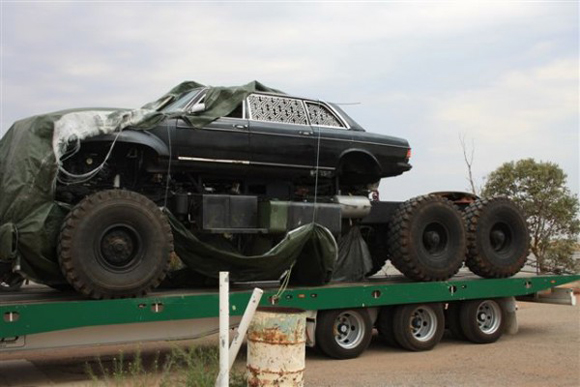Ford Fiesta, 2011The Ford Fiesta is the next milestone under the ONE Ford plan to design and develop vehicles that meet the differing needs, wants and expectations of customers around the world. More than 500,000 Fiestas have already sold to customers in Europe and Asia.
When developing the new Fiesta, Ford conducted extensive global customer research. Findings clearly indicated the need for style topped the list of customer desires everywhere in the world. In Europe, across North America and in the Asia Pacific region, customers are looking for a distinctively designed small car that offers world-class quality, convenience, comfort and connectivity.
The anticipated new Ford Fiesta arrives in North America with strong consumer awareness, thanks to the Fiesta Movement program. With 100 social media mavens chronicling their experiences of driving European market Fiestas on American roads, Fiesta has generated more than 675,000 Flickr views and more than 5.5 million YouTube video views.
Kinetics and aesthetics
Kinetic design imparts a sense of movement - even while standing still - harmonizing character elements to reflect global Ford identity, enabling Ford Fiesta to project its own air of confidence, style and individuality. Fiesta targets a youthful "design progressive" mind-set, a consumer group that values style and diversity as worthy assets.
Up front, Ford Fiesta sports the global Ford face, centering the Blue Oval badge on the grille over the signature inverted trapezoid lower grille opening. These subtle cues engender familiarity across the portfolio, providing aesthetic linkage between the distinctive new Ford Taurus, the fuel-efficient midsize Fusion and the bold Fiesta.
The Ford Fiesta face are sweeping, elongated headlamps that frame and connect the hood to muscular, sculpted front fenders. Available in sporty five-door hatchback or four-door sedan body styles, Ford Fiesta provides ample space for occupants and their gear.
The Ford Fiesta design is further enhanced with a choice of nine vivid new colors. From Bright Magenta through Lime Squeeze to Blue Flame, Fiesta's broad color palette - more available colors than any other segment competitors - instills vibrant individuality.
The InsideFord Fiesta is as dramatic on the inside as it is on the outside. Boldly sculpted surfaces, contrasting colors and comfortable, supportive materials make the interior as individual as the driver.
The instrument panel centerstack - focal point of the new Fiesta interior - was designed to feel as useful and familiar as the keypad on a mobile phone.
The North American Ford Fiesta features first-row bucket seats with a 60/40 split second-row seat. Cloth or leather seating surfaces vary by trim level offering comfort, style and individuality. High series Ford Fiestas also offer leather with sporty contrast accent color piping.
Soft, sculptured surfaces and the centerstack layout provide the Ford Fiesta with a sense of harmony. Intuitive switchgear placement, comfort zone seating and available ambient lighting allow a driver to maximize the mood with seven complementary colors - switchable among three levels of intensity - for interior accent lighting.
Fuel efficiency
The Ford Fiesta's flowing sculpted hood covers a 1.6-liter DOHC I-4 engine with an estimated 119 horsepower and 109 ft.-lbs. of torque. Spirited performance and fuel-efficient economy are signature attributes with the Ford Fiesta expected to deliver best-in-class fuel economy at 40 mpg.
Ford Fiesta's advanced 1.6-liter engine features Twin Independent Variable Camshaft Timing (Ti-VCT) allowing the engine to be downsized for fuel economy while continuously optimizing camshaft phasing for throttle response, performance and flexibility.
Big results from a small package are possible with several new technologies in this new global engine, including an advanced new front end accessory drive (FEAD) belt with stretchy dynamics to improve the engine's thermal dynamics. The elasticity in this new drive belt eliminates the need for a belt tensioner and contributes to overall fuel economy.
Ford Fiesta features a standard five-speed manual transaxle with gear ratios selected to offer spirited off-the-line performance and exceptional fuel economy for drivers who desire three pedals and a stick shift to maximize driving experience.
Specially tuned front struts, bushings, dampers, stabilizer bars and a rear twist-beam axle keep Ford Fiesta sure-footed and firmly planted. Sporty, European driving dynamics prevail.
Power steering conserves fuel
For confidence-inspiring on-road dynamics, Ford Fiesta features Electric Power Assist Steering (EPAS) which reduces complexity while saving weight and fuel. This advanced system is speed-sensitive - providing optimized assist based on speed, cornering forces and acceleration or deceleration.
The Ford is aggressively moving to EPAS across its product lineup. The system already is available in several Ford, Lincoln and Mercury nameplates, and by 2013 nearly 90 percent of Ford's lineup will offer this fuel saving technology.
Strength, safety, quality and quiet
More than 50 percent of Ford Fiesta's welded body structure is made from high-strength steel, with ultra-strong boron steel used in several critical areas. This rigid body shell contributes to Fiesta's confident road-holding, best-in-class occupant safety and quiet composure.
The Ford Fiesta safety is enhanced by an array of features including dual-stage first-row air bags, a class-exclusive driver's knee air bag, side air bags and side curtain air bags. AdvanceTrac® with ESC (Electronic Stability Control) is standard on Ford Fiesta, along with seat belt pretensioners, rear door child safety locks and a Safety Canopy® system.
Fiesta NVH (noise, vibration and harshness) control is taken to a new level of quiet for this segment, helped in part by a specially laminated, class-exclusive windshield that was chosen to help absorb and contain noise. Engine noise is subdued by a hood blanket, with enhanced door seals keeping wind noise minimized.
Special padding behind the instrument panel and foam baffles mounted inside the pillars keeps Ford Fiesta quiet. Even the headliner material was specified for its sound-deadening qualities.
Much of Ford Fiesta's sound-absorbent materials are comprised of recycled content, helping to conserve resources as it preserves peace and quiet. In addition, Ford Fiesta aerodynamics contributes to both NVH control and fuel efficiency.
Features and functionality
From class-exclusive automatic climate control to a standard aux input, Ford Fiesta offers customers a number of standard and available features that increase convenience and add connectivity. Among them is Ford SYNC®, integrating a driver's mobile phone with Fiesta's onboard, voice- activated communications and entertainment system.
Ford Fiesta offers keyless entry and push button start, a feature unique within the segment. Drivers of all sizes can adjust the tilt-and-telescoping steering wheel to suit their individual preferences. Reflecting Ford Fiesta's versatility and adaptability, adjustable cup holders can accommodate Red Bull cans and Big Gulps along with every container size in between.


























































